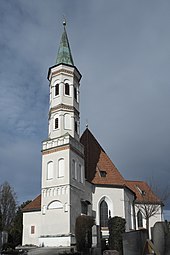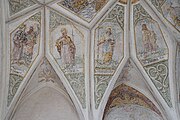St. Salvator and Sebastian (Weilheim in Upper Bavaria)
The Catholic cemetery church of St. Salvator and Sebastian in Weilheim , a town in the Upper Bavarian district of Weilheim-Schongau , was built in the 15th century in the Gothic style. The church has a winged altar from the late 15th century and is completely painted with frescoes from around 1600. It is consecrated to Jesus Christ , the Salvator mundi (savior of the world), and St. Sebastian , who is also venerated as the plague saint . The church is one of the protected architectural monuments in Bavaria.
history
Betberg, located northeast of Weilheim's old town, served as a cemetery for the plague dead during the great plague epidemic in 1349. In 1449 a pious widow named Seitz had a chapel built there, which was expanded in 1481 with a choir . In 1521, the cemetery, which was originally located in the city center at the parish church of the Assumption of Mary , was moved in front of the city gates to the place of the former plague cemetery and the chapel became a cemetery church. In 1526 a vestibule was added to its south-west side and the tower was built in 1584 by Hans Guggemoos. In 1852 the onion hood , which was put on in 1794, was replaced by a pointed helmet.
architecture
Exterior construction
The tower is divided into two square and two octagonal floors and richly decorated with blind arches and terracotta friezes . A clay relief depicting Salvator mundi is set into the outer wall above the entrance to the vestibule . Next to it you can see a stone slab with the year 1526. The holy water font carved in stone in the vestibule is marked with the year 1618. Ogival glare fields are cut into the outer walls of the eight-sided central building . The front wall of the choir , which is closed on five sides , is broken through by a late Gothic tracery window.
inner space
The interior is accessed via a vestibule, which is vaulted by a pointed arched needle cap barrel. The central area is spanned by a multi-part mesh rib vault that rests on a slender central column . Shield arches structure the walls. The choir adjoining to the east is also covered by a ribbed vault.
Frescoes
The walls and vaults are covered with a cycle of frescoes depicting the Passion of Christ, which was executed between 1591 and 1615 by the painter Elias Greither (Greuter) the Elder , who lives in Weilheim . The individual scenes were donated by the citizens of Weilheim and are decorated with their coat of arms, the inscriptions reflect their names. The frescoes on the walls of the vestibule depict the condemnation of St. Sebastian and the miracle of Jesus.
In the course of a restoration in 1867, the old plaster was pecked to give a new layer of plaster a better hold, the frescoes were painted over in the neo-Gothic style . In 1906 the neo-Gothic painting was removed and the old frescoes exposed again. The wall surface of the window on the southeast side, which was bricked up in 1867, is provided with a modern depiction of St. Leonhard against the background of the city of Weilheim and the martyrdom of St. Sebastian.
Wall and ceiling frescoes in the central room
The two windows of the central room are framed by a representation of Christ as Salvator mundi, a Madonna and Child, Saint Catherine and Saint Barbara, and two other saints. The three large frescoes on the walls depict the Last Supper , Jesus before Caiaphas and Jesus before Pilate .
The Passion cycle begins on the vaulting with the scene of Christ entering Jerusalem, with the city of Weilheim serving as the backdrop. This is followed by the washing of the feet, the imprisonment in which Peter cuts off Malchus' ear, two further scenes Jesus before Caiaphas and Jesus before Pilate, the flagellation and the crowning of thorns. The last scene shows Pilate "washing his hands in innocence". Under the scenes you can see inscriptions with the names of the donors, including their coats of arms.
Frescoes on the central column
The frescoes on the central column depict: Crucifixion, Descent from the Cross, Entombment, Descent into Hell, Resurrection and Ascension of Christ. Here, too, inscriptions with the names of the donors can be read under the frescoes and their coats of arms can be seen underneath.
Vault frescos in the choir
The vaulted areas of the choir are dedicated to the twelve apostles. They surround the coats of arms of the Bavarian Duke Wilhelm V (1548–1626) and his wife Renata of Lorraine (1544–1602). The Last Judgment is depicted on the choir arch .
Furnishing
- The choir altar , a Gothic winged altar with a renewed shrine, was created around 1470/80 by an unknown master. The painting on the central panel depicts the mercy seat , surrounded by Mary and John the Baptist . In the foreground you can see the book with seven seals on which a dove sits, symbolizing the Holy Spirit . Saint Sebastian is depicted on the left panel, the figure on the right panel is interpreted as Saint George or Saint Achatius . The outside of the wings depict the Annunciation , on the left the Archangel Gabriel , on the right Mary, over whom the dove of the Holy Spirit hovers.
- The so-called Greitheraltärchen was donated in 1611 by Elias Greither the Elder and his wife for the infirmary of the Benediktbeuern monastery and after the secularization came to the Weilheim cemetery church. The paintings, the annunciation scene in the middle, God the Father in the excerpt and the predella scenes were made by Elias Greither, the sculptures of Anna selbdritt and the prophet Elias are by Bartholomäus Steinle .
- The votive tablet from 1646 comes from the former Augustinian canons' church Heilig Kreuz in Polling . It is reminiscent of an episode from the Thirty Years' War and depicts Pöltner Strasse and the Pöltner Tor, which was demolished in the 19th century, the Pollinger Cross is shown on the top left .
Gravestones and epitaphs
Two painted epitaphs from the 17th century hang in the choir . The souvenir picture for the Dumperger family is marked with the year 1618.
Next to the choir altar, the tombstone for the mayor Hans Rait († 1608) is set into the wall. The relief depicts the deceased kneeling in front of the crucified one.
Further tombstones from the 16th century are housed in the vestibule. They are decorated with reliefs and coats of arms. The tombstone for the mayor Hans Engelhard († 1558) has a relief of the Annunciation scene. A priest's grave stone from the 15th century depicts the deceased in a life-size full-length figure standing under an arcade.
organ
The organ builder Josef Maier from Hergensweiler built a new organ with four stops on a manual and attached pedal in the cemetery church in 1995 . The instrument with sliding drawer and mechanical play and stop action has the following disposition :
|
|
|||||||||||||
literature
- Georg Dehio: Handbook of the German art monuments. Bayern IV: Munich and Upper Bavaria . 2nd edition, Deutscher Kunstverlag, Munich 2002, ISBN 3-422-03010-7 , pp. 1264-1265.
- Joachim Heberlein: The churches and chapels in the parish community Weilheim i. OB . Kunstverlag Josef Fink, Lindenberg 2013, ISBN 978-3-89870-850-0 .
- Georg Paula , Stefanie Berg-Hobohm : District Weilheim-Schongau (= Bavarian State Office for Monument Preservation [Hrsg.]: Monuments in Bavaria . Volume I.23 ). Lipp, Munich 2003, ISBN 3-87490-585-3 , pp. 547-550 .
Web links
Individual evidence
- ↑ List of monuments for Weilheim in Upper Bavaria (PDF) at the Bavarian State Office for Monument Preservation, monument number D-1-90-157-28
- ↑ Michael Bernhard (Ed.): Organ database Bavaria online. Record 30369. 2009. Retrieved March 2, 2020.
Coordinates: 47 ° 50 '32.2 " N , 11 ° 8' 56.9" E
































